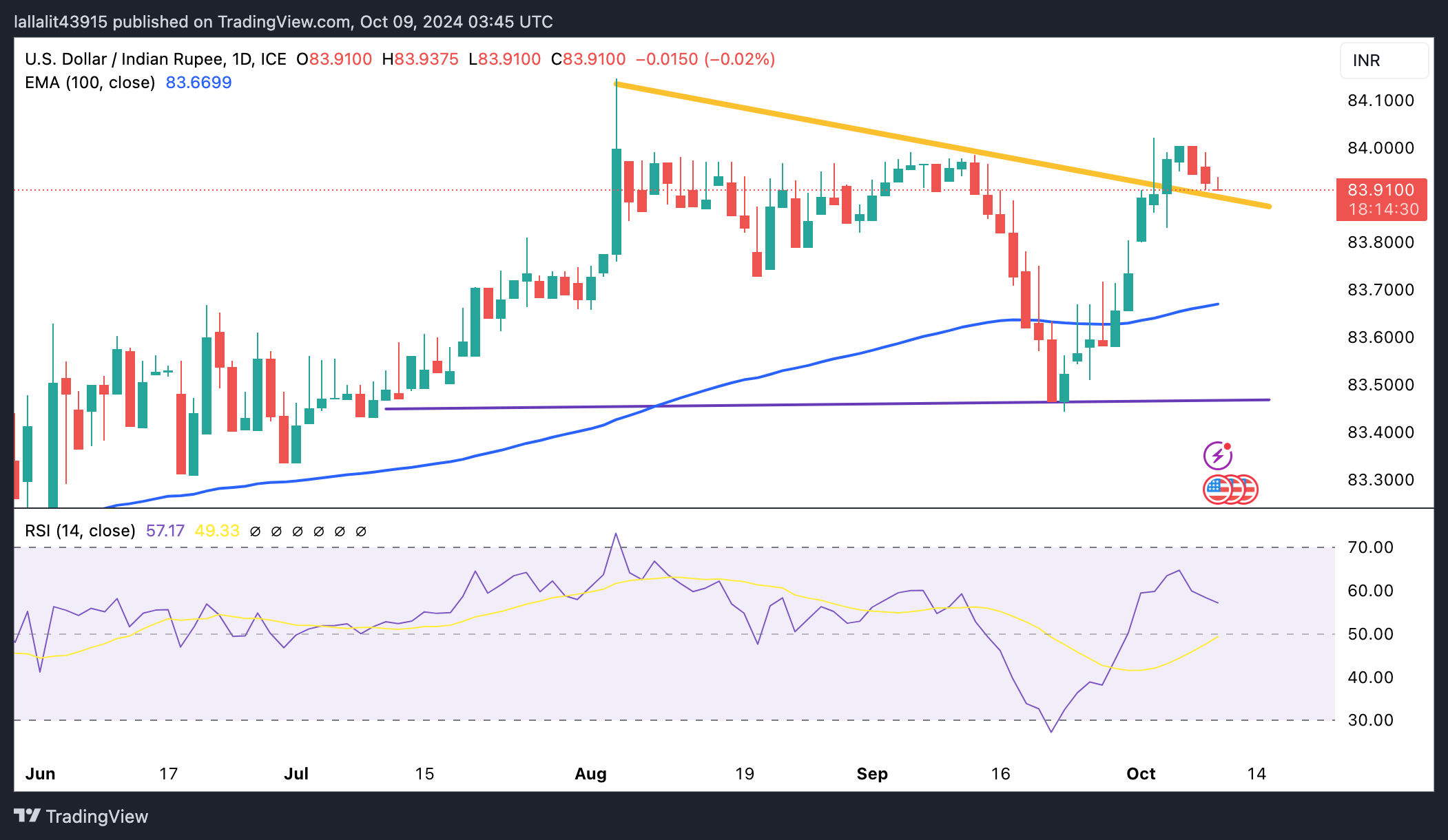USD/INR softens ahead of RBI rate decision
- The Indian Rupee gains traction in Wednesday’s Asian session.
- Lower crude oil prices and potential RBI’s foreign exchange intervention support the INR.
- Investors await the RBI interest rate decision on Wednesday ahead of FOMC Minutes.
The Indian Rupee (INR) gathers strength on Wednesday, bolstered by a decline in crude oil prices, stronger Asian currencies and likely foreign exchange intervention from the Reserve Bank of India (RBI). Nonetheless, outflows from local equities and renewed US Dollar (USD) demand might cap the upside for the local currency.
Investors will closely monitor the Reserve Bank of India (RBI) interest rate decision on Wednesday, which is likely to maintain its policy rate but might adopt a 'neutral' stance. On the US docket, the Federal Reserve's (Fed) September meeting minutes will be in the spotlight.
Daily Digest Market Movers: Indian Rupee edges higher on likely RBI intervention
- “A rise in oil prices coinciding with dollar strength has increased inflation risks in India and put pressure on the rupee, such that the RBI has had to undertake significant FX intervention in recent days," noted J.P. Morgan analysts on Tuesday.
- India’s foreign exchange reserves rose to a record-breaking $704.89 billion as of September 27, marking an increase of $12.5 billion, according to the RBI.
- Federal Reserve Vice Chair Philip Jefferson said on Tuesday that risks to the central bank’s employment and inflation goals are now closer to equal, per Bloomberg.
- Boston Fed President Susan Collins noted on Tuesday that with inflation trends growing weaker, it is very probable that the Fed can deliver more interest rate cuts.
- The markets have priced in nearly an 87% chance of 25 basis points (bps) Fed rate cuts in November, up from 31.1% last week, according to the CME FedWatch Tool.
Technical Analysis: USD/INR’s positive outlook prevails
The Indian Rupee trades firmer on the day. The USD/INR pair keeps the bullish vibe above the descending trend line and the key 100-day Exponential Moving Average (EMA) on the daily timeframe. The path of least resistance level appears to the upside as the 14-day Relative Strength Index (RSI) is located above the midline near 55.70.
The key resistance level for USD/INR emerges near the upper boundary of the rectangle and a psychological mark of 84.00. Further north, the next upside barrier is seen at the all-time high of 84.15, followed by 84.50.
On the flip side, the resistance-turned-support level at 83.90 acts as an initial support level for USD/INR. Extended losses could expose the 100-day EMA at 83.67. Any follow-through selling could see a drop to 83.00, representing the round mark and the low of May 24.

Indian Rupee FAQs
The Indian Rupee (INR) is one of the most sensitive currencies to external factors. The price of Crude Oil (the country is highly dependent on imported Oil), the value of the US Dollar – most trade is conducted in USD – and the level of foreign investment, are all influential. Direct intervention by the Reserve Bank of India (RBI) in FX markets to keep the exchange rate stable, as well as the level of interest rates set by the RBI, are further major influencing factors on the Rupee.
The Reserve Bank of India (RBI) actively intervenes in forex markets to maintain a stable exchange rate, to help facilitate trade. In addition, the RBI tries to maintain the inflation rate at its 4% target by adjusting interest rates. Higher interest rates usually strengthen the Rupee. This is due to the role of the ‘carry trade’ in which investors borrow in countries with lower interest rates so as to place their money in countries’ offering relatively higher interest rates and profit from the difference.
Macroeconomic factors that influence the value of the Rupee include inflation, interest rates, the economic growth rate (GDP), the balance of trade, and inflows from foreign investment. A higher growth rate can lead to more overseas investment, pushing up demand for the Rupee. A less negative balance of trade will eventually lead to a stronger Rupee. Higher interest rates, especially real rates (interest rates less inflation) are also positive for the Rupee. A risk-on environment can lead to greater inflows of Foreign Direct and Indirect Investment (FDI and FII), which also benefit the Rupee.
Higher inflation, particularly, if it is comparatively higher than India’s peers, is generally negative for the currency as it reflects devaluation through oversupply. Inflation also increases the cost of exports, leading to more Rupees being sold to purchase foreign imports, which is Rupee-negative. At the same time, higher inflation usually leads to the Reserve Bank of India (RBI) raising interest rates and this can be positive for the Rupee, due to increased demand from international investors. The opposite effect is true of lower inflation.



